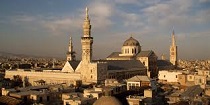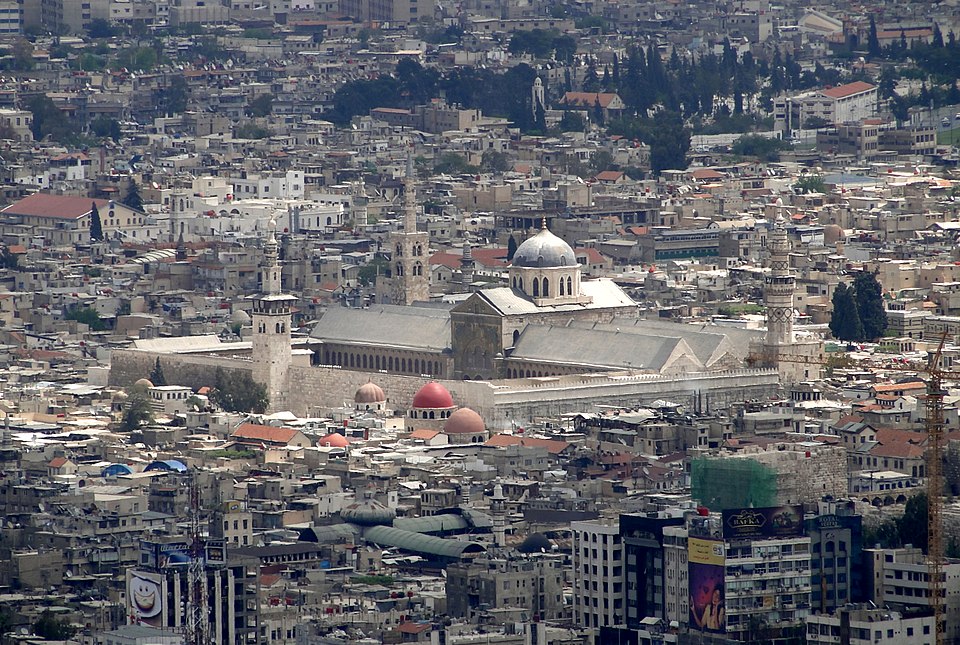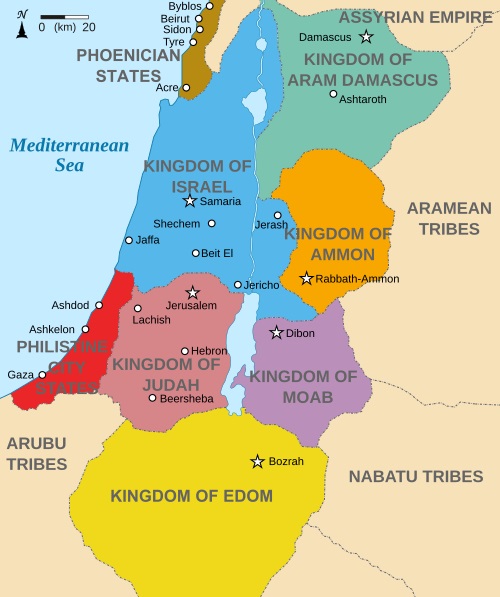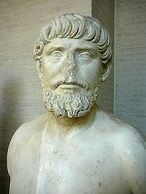

TLW's Damascusscope™ (Damascus Historyscope) |
By T.L. Winslow (TLW), the Historyscoper™ |
© Copyright by T.L. Winslow. All Rights Reserved. |
Original Pub. Date: June 17, 2017. Last Update: Oct. 23, 2025. |
Westerners are not only known as history ignoramuses, but double dumbass history ignoramuses when it comes to Damascus history. Since I'm the one-and-only Historyscoper (tm), let me quickly bring you up to speed before you dive into my Master Historyscope.


Damascus, nestled in the E foothills of the Anti-Lebanon Mts. on the shores of the Barada River on a high plateau, the capital and largest city of modern-day Syria is one of the oldest continuously inhabited cities in the world and the oldest capital city in the world, AKA as-Sam and the City of Jasmine. It has been ruled in turn by the Arameans, Greeks, Romans, Byzantines, and Muslims. It houses the Umayyad (Great) Mosque of Damascus, which goes back to the Iron Age Aramean temple of rain god Hadad, followed by the Greek temple of Zeus, and the Roman temple of Jupiter.

In the 12th cent. B.C.E. the tribal Semitic Aramean people in modern-day Syria arise, comprised of several nations incl. Aram-Damascus (ends -732).
About 7,800 B.C.E. Emmer wheat is domesticated in Damascus, Syria on the banks of the Barada River, becoming one of the oldest cities to survive to modern times - seen it all, eh, Klaatu Barada Nikto?
About 6,300 B.C.E. the city of Damascus on the E foothills of the Anti-Lebanon Mts. is settled (modern-day pop. 2.8M); in 661-750 C.E. it becomes the capital of the Sunni Muslim Umayyad Caliphate.
In 2,255 B.C.E. Manishtushu dies, and his son Naram-Sin of Akkad (d. -2218) becomes king #4 of Sumer and Akkad, expanding to the Zagros Mts. and destroying the city of Ebla in NW Syria (later rebuilt); his soldiers first use the composite bow, which is able to penetrate leather armor and has 2x the range of simple bows; he makes the first known treaty in history with the king of Elam, who becomes his vassal; an inscription mentions Aram (Damascus) as a place along the Upper Euphrates River.
About 1000 B.C.E. the ancient city of Damascus in Syria on the Barada River E of the Anti-Lebanon Mts. (ruled by Egyptians and Hittites) becomes an independent Aramaean kingdom.
In 965 B.C.E. King Ezron (Rezon) (the Syrian) of Aram-Zobah conquers Damascus, going on to fight with the Israelite kings Saul then David, who defeats Zobah and makes it tributary to Israel (2 Sam. 10) until the accession of Solomon, when it becomes independent again (1 Kings 11:23).
In 843 B.C.E. King (since -865) Ben-Hadad II (Hadadezer) (Adad-Idri) of Damascus sends to inquire of prophet Elisha if he will recover from his sickness, and the latter predicts that he will die and that Hazael will rule in his place; the next day (842 B.C.E.) Hazael suffocates the king under a wet "netted cloth" and becomes king of Aram-Damascus (2 Ki. 8:15), going on to fight the Assyrians and gaining influence over the N Syrian state of Unqi, expanding its borders over large parts of modern-day Syria and Israel-Samaria, conquering Israel and reaching most of the Golan to the Sea of Galilee.
In 737 B.C.E. Pekahiah is murdered by his general (adjutant) Pekah (d. -732) (Heb. "open-eyed") (son of Remaliah) and 50 men of Gilead, and Pekah becomes the 20th and penultimate king of the 10-tribe kingdom of Israel (2 Ki. 15:25-27), going on to reign for 20 years while continuing the idolatrous calf worship (2 Ki. 15:28); Pekah allies with Aram-Damascus king (since -754) Rezin (d. -732) to attack king (since -745) Tiglath-Pileser III (d. -727) of Assyria, trying to coerce King Ahaz of Judah to join, causing him to appeal to Tiglath-Pileser III - two decades of frightful fashion and big hair?
In 732 B.C.E. after pissing him off by attempting to coerce King Ahaz of Judah to take action against Assyria in league with King Rezin of Damascus, Israeli King Pekah is murdered by pro-Assyrian party head Hoshea (Heb. "salvation") (son of Elah), who becomes king #21 (last) of the 10-tribe kingdom of Israel based in Samaria (until -721) after paying Assyrian king Tiglath-Pileser III (Pul) 10 talents of gold and 1K talents of silver as tribute; an 8-year interregnum begins (2 Ki. chs. 14-15, 2 Chron. ch. 26)?; too bad, when Tiglath-Pileser III dies in -727, Hoshea conspires with Egypt to rebel, causing his successor Shalmaneser V to invade; meanwhile Judah calls on Assyria for help in its war with Israel and Aram-Damascus, and Tiglath-Pileser III conquers the Galilee and exiles many of its inhabitants, going on to capture Aram-Damascus and transport its pop. to their original homeland Kir, dividing the Aramean kingdom (founded -1000) into six provinces centered around Damascus, and annexing one-half of Israel; the Jews are exiled from Perea (E of the Jordan River).
In 572 B.C.E. the Neo-Babylonians conquer Damascus.
In 538 B.C.E. the Persian Achaemenid Empire (founded in -550 by Cyrus II the Great) annexes Damascus (until -333).
In spring 333 B.C.E. in the spring Memnon of Rhodes dies during the siege of Mytilene, causing Darius III to withdraw his Greek mercenaries into Syria and gather a large army. Alexander III the Great subdues Ancyra (modern-day Ankara), Caria, and Cilicia, then advances into Syria; in Nov. he defeats Darius III in the SE corner of Asia Minor at the Battle of Issus, a seaport on a narrow coastal strip between high mountains and the Gulf of Issis in Cilica (near modern-day Alexandretta, Syria), causing Darius to offer him 10K talents plus all of Asia W of the Euphrates if he backs off, but Alexander demands unconditional surrender, which he obtains from Damascus; Alexander takes Memnon of Rhodes' widow Barsine (-363 to -309) .
In 112 B.C.E. Damascus falls to Seleucid king (since -116) Antiochus IX Cyzicenus (until 150 C.E.).
In 64 B.C.E. the Romans conquer Damascus, assimilating their rain-thunder god Hadad to Jupiter.

In 37 B.C.E. big mean pharisee Saul of Tarsus is chasing pesky Christians near Damascus when he has a transformative vision of Christ, converting to Christianity and changing his name to Apostle St. Paul (5-65), becoming the main founder of Christianity and making Damascus the city central to early Christianity.

In 60 C.E.Roman architect Apollodorus Mechanicus(d. 130) is born in Damascus, going on to become Emperor Trajan's favorite architect, becoming known for making the dome a standard; he goes on to redesign the old Temple of Jerusalem in Damascus.
In 150 C.E. Damascus is made a Roman provincial city by Emperor Trajan's cousin Hadrian.
In 391 C.E. after issuing the Theodosian Decrees beginning in 389 C.E., Roman emperor (379-95) Theodosius I converts the pagan Temple of Jupiter in Damascus to Christian.
In 613 C.E. the Persians capture Damascus and Tarsus from the Byzantines.
In June 634 C.E. Rashidun gen. Khalid ibn al-Walid (585-642) leads a half-army of 9K Arab Muslim Saracens (Arab. "shirqiyyeen" = easterners) into Syria, hooking up with 23K more under gens. Abu Ubaidah ibn al-Jarrah, Yazid bin Abu-Sufyan, Sharjeel bin Hosanna, and Amr ibn al-Aas and taking Sawa, Aarak, Tarmad, Sakhna, Qadma, Qarteen, Hawwareen before reaching the Uqab Pass 20 mi. from Damascus; in July the First Battle of Marj Rahit near Damascus (2nd in 684) sees the Ghassanid Arabs (allies of the Byzantine Empire) defeated by the Rashidun army under Khalid bin Walid, clearing the Muslim army's rear so they can advance toward Bosra (Bostra) (modern-day Busra al-Sham) 67 mi. S of Damascus (capital of the Ghassanids, formerly capital of the Roman Province of Arabia); on July 30 the 32K-man Rashidun army defeats 12K Roman troops at the Battle of Bosra (Bostra), becoming the first Byzantine vassal to be captured by the Muslims; in July the Rashidun army defeats the 80K-man Byzantine army at the Battle of Ajnadayn in S Palestine, building a mosque inside the ancient Temple of Jupiter, which had been converted into a fortress, after which they sweep up the coast of Palestine as far as Caesarea, forcing Jews to convert by the sword and massacring 4K Jewish, Christian, and Samaritan peasants, which really hits the Samaritans hard - by 2007 there are only 712 left; on Aug. 21-Sept. 19 the Siege of Damascus sees 20K Muslims under Khalid ibn al-Walid take Damascus, defended by a 15K-16K army under Thomas with heavy Byzantine Christian losses after a Monophysite bishop tells the Muslims of a weak spot in the walls at night, allowing them to enter at the Eastern Gate, after which Abu Ubaidah negotiates surrender terms with the cmdr. of the Byzantine garrison, sparing the lives the pop. and allowing them to practice their faith incl. their non-Chalcedonian anti-Monothelete doctrines without pressure from Constantinople in return for accepting Muslim Sharia rule incl. payment of the jizya, which al-Walid reluctantly agrees to for fear that doing what Allah wants and massacring them will stiffen resistance in other towns; after waiting three days, Khalid ibn al-Walid pursues the refugees and defeats them near modern-day Al Jayyad; he goes on to remain undefeated in 100+ battles.
On Aug. 15-20, 636 C.E. 25K-40K Muslim Arabs under Gen. Khalid defeat 80K-100K Byzantines under Heraclius I at the epic Battle of Qadisiyya (Yarmuk) (Yarmouk) on the banks of the Yarmuk River (tributary of the Jordan River) near Hira, with 50K Byzantines vs. 4K Muslims KIA, and capture Damascus, which becomes the capital of the caliphs (until 750), and which they go on to fortify and adorn while going on to annex the rest of the Levant, making Syria (part of the Roman empire since 64 B.C.E.) Muslim; part of the reason for their defeat is that the Byzantines are used to hiring Christian Ghassanid Arab auxiliaries for their cavalry, most of whom double-cross them and switch sides, leaving them up Shit Creek without a paddle - we Arabs now have our own faith, so screw you?
Jerusalem changes hands for the ???th time, this time for four centuries? On Aug. 24, 1516 C.E. the Ottomans under Selim I defeat the Mamluks at the Battle of Marj Dabiq (Marjdabik) (Marg Dayek) 26 mi. N of Halab (N of Aleppo) in Syria; the Morons, er, Mormons, er, Mamluks refuse to use gunpowder and artillery, calling it a "dishonorable weapon", relegating it to inferior units while taking on the Ottomans with valor and elan instead; Selim I then takes Aleppo, followed on Sept. 26 by Damascus, then Palestine, incl. Jerusalem (3rd most holy city in Islam) on Dec. 28; the Mamluk empire in Syria (founded 1250) ends, and the gunpowder-toting Automatic Ottomans rule the roost; on Dec. 30 Sultan Selim I secretly visits Jerusalem for devotions, then annexes all of Syria and moves on to Cairo. In Aug. Henry VIII has the 1290 Round Table of Arthur in the Church of Winchester repainted by an artist from Southampton, with his own face for Arthur, believing that the Welsh Tudors are a fulfillment of the prophecy that Arthur will rule England again; he also has visions of becoming HRE until his split with the pope; too bad, when he later begins destroying the old Medieval Catholic culture of England he has the bones of Arthur and Guinevere in Glastonbury destroyed - which makes Arthur un-PC among the Tudors, becoming the reason that S hakespeare never writes a play about him?

On June 28, 1832 C.E. Egyptian forces under Mehmet Ali's eldest son Ibrahim Pasha (1789-1848) retake Damascus, which has been under Egyptian control since 1516 (until 1841), giving them control of all of Syria, after which they halt while Mehmet Ali tries to negotiate with the sultan, and when that fails, they march into Anatolia, threatening Konya, which is captured on Nov. 21, causing Sultan Mahmud II to send a large army to stop them.
On July 15, 1840 C.E. the 1840 London Convention for the Pacification of the Levant London Straits Convention (Protocol des Droits) is signed by the U.K., Austria, Prussia, Russia, and the Ottoman Empire in return for the latter closing the Dardanelle Straits to all warships in peacetime, and the Black Sea to Russian warships, offering Mehmet Ali permanent control over Egypt and Acre under Ottoman suzerainty if he withdraws his forces from Syria, Hijaz (Arabia), the Holy Land, Crete, and Adana within 10 days and returns the defecting Ottoman fleet in Alexandria; too bad, after obtaining naval backing by France led by Adm. Julian Pierre Anne Laland,, Mehmet Ali declines, leading to the Oriental Crisis of 1840, during which British and Austrian forces attack Syria and Alexandria in Sept., shelling Sidon and Beirut on Sept. 11, followed by Acre on Nov. 3, capturing it in Nov.; meanwhile in Oct. France chickens-out and switches sides, and on Nov. 27 faced with revolts in occupied territories and a gen. deterioration of his military he finally accepts the terms, signing the Convention of Alexandria, negotiated by British Adm. Charles Napier, abandoning all claims to Syria (incl. Damascus) and returning the Ottoman fleet, whle claiming Egyptian status as a unprecedented privileged hereditary Ottoman province with a standing army of 18K men and rule over Sudan, which Egyptian nationalists later use as a legal basis for fighting British occupation; meanwhile Britain occupies Aden in S Yemen to stop Egyptian advances; it takes a cent., but in 1937 England makes Aden a British crown colony; Britain emerges as an active player in the Middle East as the Ottoman Empire's ally for the next 37 years, with the right to enter the Straits in times of war, while Russian relations with the Ottomans begin to deteriorate.
In 1840 the Damascus Affair results after Cappucine priest Tommaso disappears, and a number of Jews are tortured into confessing that they used his blood to make matzoh (the "blood libel"); an internat. effort led by Britain, Austria and the U.S. frees them, becoming the first U.S. diplomatic action in the Middle East.
On May 23. 1860 the 1860 Civil Conflict in Mount Lebanon and Damascus between Druzes and Christians begins in Mount Lebanon (ends July 11), starting with Druze massacres of Christians that spread throughout Ottoman-run Syria into Damascus, until a French-led internat. military force intervenes.
On July 16, 1860 C.E. a Muslim uprising in the Christian neighborhood of Bab Tuma in Damascus sees a mob of Druzes, Bedouins, Arab Muslim civilians, and Kurdish auxiliary forces massacre 6K Christians and destroy the Christian quarter before Algerian-born Sufi leader Abdelkader El-Djezairi (1808-83) intervenes to stop it, becoming an internat. hero despite devoting his life to stopping Westernization of the Muslim World - no more Pauls on Straight Street?


The Allies capture Damascus, ending 400 years of Ottoman rule (since 1516)? On Oct. 1, 1918 C.E. after they are ordered to cut the Turkish retreat to the N at Hama, and unknown to them the Turks evacuated the world's oldest city Damascus overnight, and they decide to cut through the N part, the 3rd Australian Light Horse Brigade of the Desert Mounted Corps inadvertently captures the city after some officials surrender it to them and the main Turkish barracks surrenders without a fight after being impressed with the size of their horses, after which on Oct. 1 the Arab Sharifian army under emir Faisal bin Hussein bin Ali al-Hashemi (who was supposed to capture it), accompanied by British Lt. Col. T.E. Lawrence of Arabia in a Rolls-Royce escorted by Indian cavalry arrive from the E and occupy it while looting the city and murdering innocent civilians and hospital patients, causing British Field Marshal Sir Edmund Allenby to rush 120 mi. from Tiberias and order the Australians back to restore order and protect the civilian pop. on Oct. 2, installing Faisal (who dreams of one Sunni Muslim Arab state in the Fertile Crescent) as local govt. administrator, while his troops proclaim him King Faisal I (1885-1933) of Syria (whose portrait bears a striking resemblance to actor Sir Alec Guinness (1914-2000)?); too bad, Allenby fails to tell him of the secret 1916 deal to put Syria, Lebanon, and N Mesopotamia under French control; on Oct. 3 the British arrive; when the French arrive, their cmdr. marches to Saladin's tomb and announces "Nous revenons, Saladin" (We return, Saladin); Christian missionaries and local Christians incl. the Lebanese Marionites are given privileges to proselytize Muslims, pissing them off.
In Jan. 1920 Emir Faisal (Faysal) (son of Sharif Husayn of Mecca) returns to Damascus as king of an independent Syria after negotiating the French military occupation of Lebanon (which is declared the state of Greater Lebanon by French Gen. Gouraud) and the coastal regions of Syria; on Mar. 8 the 2nd Gen. Syrian Congress in Damascus declares Syrian independence and chooses Faisal as king, and in Apr. France is awarded the mandate over Syria; too bad, when Faisal's agreement is not accepted by the Syrians, the French invade in July, and defeat the Syrians on July 23 at the Battle of Maysalun Pass 12 mi. W of Damascus, occupying Damascus and forcing him into exile in Britain in Aug.; in July the French occupy Aleppo, with the Syrians holding out in the Alawi region around Latakia and W of Aleppo until the end of 1921; on Sept. 1 France establishes admin. territories in Syria under the mandate, with Greater Lebanon (incl. Mt. Lebanon, the Biqa, and Tripoli-Sidon-Tyre) as an admin. district of Syria (until 1922), with a combined pop. of 2.2M, 85% Muslim and of them 80% Sunni; too bad, only the Lebanese Christians (Beirut, Mt. Lebanon) want to be separate from Syria.

On June 10, 2000 Hafez al-Assad (b. 1930) dies of a heart attack in Damascus after 29 years in power (since Mar. 12, 1971), and on July 10 his British-trained opthalmologist son Bashar al-Assad (1965-) succeeds him as pres. (dictator but nice?) of Syria (until Dec. 8, 2024), getting promptly promoted from col. to lt. gen. and running a mean dictatorship that uses his Ba'athist secret police to terrorize dissidents while failing to perpetuate his father's personality cult, leading to defections, which he plasters over with loyalists from Alawite clans, causing a growing opposition to form that eventually brings him down; the Damascus Spring of intense political-social debate begins until the govt. suppresses it in fall 2001, arresting dissident economist Aref Dalila (1943-) and sentencing him to 10 years for calling for freedom of expression and an end to govt. monopolies; he is released on Aug. 10, 2008.
On Jan. 6, 2012 a suicide attack on a bus carrying police in Damascus, Syria kills 25.
On Jan. 18, 2012 Assad forces withdraw from Al-Zabadini 19 mi. from Damascus, giving the rebel Free Syria Army control of some territory for the first time.
On Jan. 26-27, 2012 in Syria security forces kill 120 as Euro and Arab nations call on the U.N. Security Council to pressure Bashar Assad to stand down; on Jan. 27 after the Free Syria Army captures it; massive demonstrations are staged in Saqba (near Damascus).
On Feb. 6, 2012 Syrian govt. shelling of Homs kills 17+; meanwhile the hacker group Anonymous pub. hundreds of emails from Pres. Bashar al-Assad, the U.S. closes its embassy in Damascus, and the U.K. recalls its ambassador, and Turkish foreign affairs minister Ahmet Davutoglu utters the soundbyte that Turkey is "open to all Syrians who want to flee from oppression."
On Feb. 7, 2012 Russian foreign minister Sergey Lavrov visits Damascus and meets with Bashar al-Assad, claiming that he commits to end the violence; meanwhile France, Spain, Italy, the Gulf Arab States, and Netherlands recall their ambassadors.
On Feb. 18, 2012 a funeral procession in Damascus, Syria for those killed in protests is fired on by security forces; meanwhile China urges all sides to end the violence.
On Mar. 15, 2012 Turkish intel reports that 20K Syrian soldiers have deserted in the last 1 mo.; meanwhile Turkey threatens to launch a military operation into Syria to protect refugees, and the U.N. announces a humanitarian mission, while thousands demonstrate for Assad in Damascus.
On Mar. 17, 2012 two bombings in Damascus, Syria kill several police and civilians; meanwhile Saudi Arabia announces that it's sending weapons to the Syrian rebels.
On Mar. 25, 2012 Pres. Obama and Turkish PM Recep Tayyip Erdogan hold talks concerning transitioning Syria to a "legitimate government" by aiding the rebels; meanwhile Kofi Annan and Dmitry Medevedev discuss a harder stance on Assad's regime, while the rebels attack a military base near Damascus and the Syrian army continues its bombardment of Homs.
On Apr. 10, 2012 the deadline arrives to start implementing the truce in Syria.
On Apr. 11, 2012 U.S. secy. of state Hillary Clinton arrives in Istanbul for talks on the Syrian civil war; meanwhile Britain announces plans to give £5M worth of equipment to the Syrian rebels.
On Apr. 16, 2012 the first U.N. military observers of the U.N. Supervision Mission in Syria arrive in Damascus to monitor the ceasefire, and on Apr. 20 Syria allows them freedom of movement; meanwhile on Apr. 16 26 are killed in Idlib, Syria, followed by 50 more on Apr. 20; on Apr. 21 the U.N. Security Council votes 15-0-0 for Resolution 2043 to send 300 more observers.
On Apr. 24, 2012 a car bomb in central Damascus, Syria injures three.
On Apr. 27, 2012 a suicide bomber at a mosque in Damascus, Syria kills nine.
On Apr. 28, 2012 the Syrian army kills 10 in Bakha, Syria N of Damascus; meanwhile the rebels stage their first seaborne assault, using inflatable dinghies, and Syria accuses U.N. secy.-gen. Ban Ki-moon of "encouraging" attacks.
On May 10, 2012 two nearly-simultaneous explosions (1kg of explosives) near the military intel HQ in Qazaz, Damascus, Syria kill 55 and injure 372.
On May 20, 2012 a roadside bomb explodes near a U.N. convoy in Douma, Damascus, Syria, killing 34.
On June 14, 2012 a suicide car bomb in the Shiite pilgrimage site of Sayyida Zaynab (Sayeda Zainab) 6 mi. S of Damascus wounds 14.
On July 15, 2012 Operation Damascus Volcano (Battle of Damascus) sees thousands of rebels infiltrate Damascus from the countryside, causing govt. forces to attack and force a retreat after three weeks of fighting (Aug. 4).
On Aug. 22, 2012 the Syrian army shells parts of Damascus, Syria, killing 47; meanwhile the U.N. estimates that 18K have been killed in the 17-mo. Syrian civil war, and China accuses the U.S. of using "red line" remarks as a questionable "calculus" to intervene militarily in yet another Middle East country.